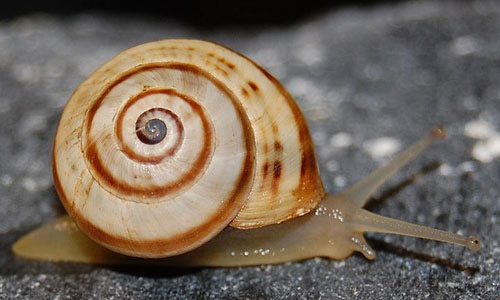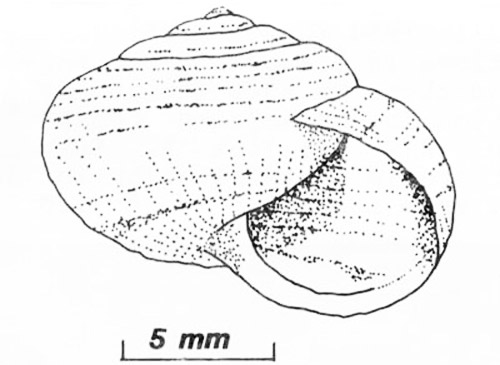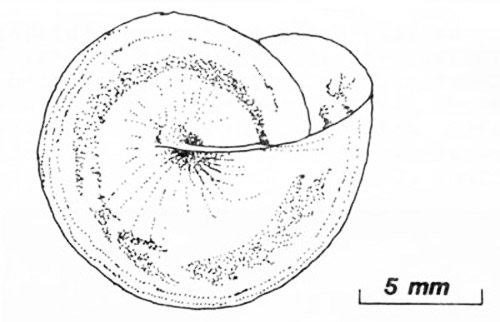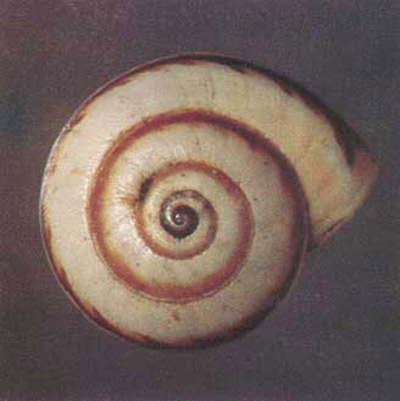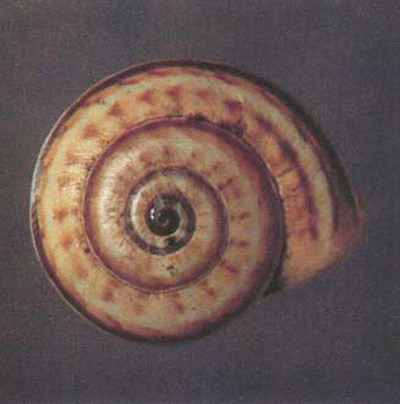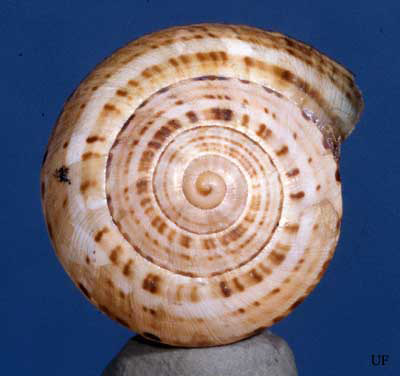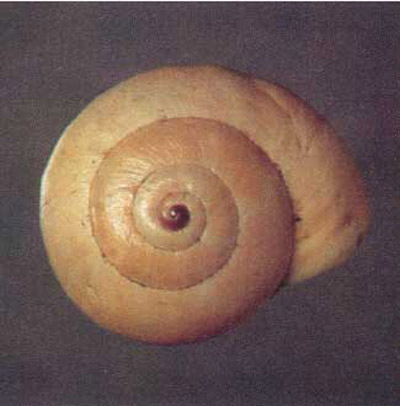common name: white garden snail
scientific name: Theba pisana (Müller) (Gastropoda: Helicidae)
Introduction - Distribution - Identification - Biology - Survey and Detection - Management - Selected References
Introduction (Back to Top)
The white garden snail, Theba pisana (Müller), is the worst potential agricultural pest of the helicid snails introduced to North America (Mead 1971). It is the most frequently intercepted foreign land snail (Hanna 1966, Mead 1971), generally arriving in shipments from the Mediterranean countries. Theba pisana shows a strong proclivity for climbing up and into freight for aestivation and is difficult to detect. This snail can survive long and arduous journeys because of its ability to form a wall of dried mucus, called an epiphragm, in the aperture of its shell which reduces water loss during dormancy.
Figure 1. The white garden snail, Theba pisana (Müller). Photograph by Esculapio.
Theba pisana is capable of explosive reproductive rates where it has been introduced, and can be found in densities of up to 3000 snails per tree (Mead 1971) after periods of less than five years (Chace 1915, Orcutt 1919). Once established, Theba pisana causes severe defoliation of a number of plants, including citrus and ornamental plantings (Orcutt 1919, Pilsbry 1939, Abbott 1950, Dekle 1962, Hanna 1966, Mead 1971). Theba pisana was previously known as Helix pasana (Müller).
Distribution (Back to Top)
Theba pisana is native in the Mediterranean countries of Europe, Africa and the Mid-East (Pilsbry 1939, Burch 1960). The type locality is Italy. Its habitat in Europe is near the coasts of Belguim, southwestern England and south Wales, east and south Ireland, western France, Netherlands, Portugal, Spain (where it is occasionally found in the inteerior) (Kerney and Cameron 1979, Schultes 2011). It has been introduced into the central Atlantic islands, Africa (Somaliland, South Africa), and southeastern Australia (including Tasmania) (Schultes 2011).
This snail was first noticed in North America in La Jolla, San Diego County, California, in 1914 (Chace 1915, Basinger 1923). It is established only in San Diego County, but has been reported both Los Angeles and Orange counties (Flint 2011). Mead (1971) reported an infestation in Los Angeles County in 1966 which was declared eradicated in 1972 (William A. Edwards, personal communication). The snails were found and identified in August 1985, in San Diego, California, at several localities in about a 10 square mile area. Hanna (1966) stated that Theba pisana has been introduced into several eastern localities in the United States. However, there are no published records for North American populations outside of California. Theba pisana is also present in Bermuda, but has never been recorded from Florida.
Identification (Back to Top)
The shell is subglobose with a moderately depressed spire. The adult shell has 5.5–6 slightly convex whorls with shallow sutures. It is of medium size, ranging from 12 to 15 mm (rarely to 25) in diameter and 9 to 12 mm (rarely to 20) in height, and is opaque and moderately solid. The umbilicus is narrow and partially to entirely covered by an expansion of the columella. The aperture of the shell is rounded and lunate and only slightly oblique. The lip of the aperture is sharp and unreflected, but some specimens show a thickening inside the lip. The juvenile shell has a sharp keel at the periphery, but in the adult shell the periphery is only slightly shouldered. The surface of the shell is not glossy, but is marked with many fine vertical striae. The background color of the shell is nearly always ivory white (rarely pink), and there are often a variable number of narrow dark-brown spiral bands present. These bands may be solid, made up of dots and dashes, or absent. This difference in coloration does not have any systematic significance because it is apparently a polymorphic trait subject to differential selection pressures and it correlates with microhabitat (Johnson 1980). The first 1 1/2 whorls are generally dark in color, ranging from tan to dark brown, and give the appearance of a dot on the apex of the shell.
Figure 2. Front (top) and basal (bottom) views of the white garden snail, Theba pisana (Müller). Graphics by Division of Plant Industry.
Figure 3. Brown banded color form of the white garden snail, Theba pisana (Müller). Photograph by Division of Plant Industry.
Figure 4. Dots and dashes color form of the white garden snail, Theba pisana (Müller). Photograph by Division of Plant Industry.
Figure 5. A lighter dots and dashes color form of the white garden snail, Theba pisana (Müller). Photograph by Paul M. Choate, University of Florida.
Figure 6. Non-banded color form of the white garden snail, Theba pisana (Müller). Photograph by Division of Plant Industry.
Biology (Back to Top)
During dry weather, most slugs and snails aestivate hidden under logs or stones or buried in the earth. However, T. pisana aestivates in the open on trees, fences, and other vertical surfaces. Pilsbry (1939) reported that T. pisana mates after rains during early November in California. Like all helicid snails, Theba pisana is a cross-fertilizing hermaphrodite. The eggs are deposited several inches in the ground a few weeks after mating. Hatching occurs after a minimum of 20 days, but may occur later during dry weather. In the active season, this snail partially defoliates a variety of shrubs and trees, including citrus. The great density of the populations in California (up to 3000 snails per tree) and the rapid rate of reproduction are primary factors in making this snail a major pest (Mead 1971).
Figure 7. White garden snails, Theba pisana (Müller), aestivating at the top of a fence post at Kadina, South Australia. Photograph by Vladimir Menkov.
Survey and Detection (Back to Top)
Searches should be directed to plants, fences, and other vertical surfaces in nature, especially in sandy areas. Crates shipped from areas where the snails are known to exist should be examined, especially the lids and corners.
Management (Back to Top)
Past infestations of T. pisana in California have been controlled and eventually eradicated by the combined use of poison sprays, poison baits, burning, and hand-picking (Basinger 1927, Pilsbry 1939, Flint 2011). These campaigns were invariably long and costly due, in part, to the way in which this snail hides itself for long periods by climbing up, on, and into bushes, trees, and man-made objects. Current recommendations include a variety of methods: cultural and mechanical methods, such as eliminating places to reduce concentrations that can more easily be checked, handpicking, traps and barriers; biological control with predatory snails; and chemical baits, which, unfortunately, are toxic to all snails and slugs (Flint 2011).
Any control program in Florida would require the use of all the above in conjunction with detailed surveys of the ground, plantings, and structures within the infected areas. The use of herbicides may be necessary in overgrown areas. Mead (1971) recommends rigid quarantine and fumigation of all suspect shipments.
Selected References (Back to Top)
- Abbott RT. 1950. Snail invaders. Natural History 59: 80-85.
- Anonymous. 1961. Interceptions of special interest at U.S. ports of entry. Cooperative Econonomic Insect Report 11: 50.
- Basinger AJ. 1923. A valuable snail poison. Journal of Economic Entomology 16: 456-458.
- Basinger AJ. 1927. The eradication campaign against the white snail (Helix pisana) at La Jolla, California. Monthly Bulletin of the California Deptartment of Agriculture 16: 51-76.
- Burch JB. 1960. Some snails and slugs of quarantine significance to the United States. Agricultural Research Service, U.S. Department of Agriculture ARS 82-1.
- Chace EP. 1915. Helix pisana Mueller in California. Nautilus 29: 72.
- Hanna GD. 1966. Introduced mollusks of western North America. Occasional Papers of the California Academy of Science 48: 1-108.
- Johnson MS. 1980. Association of shell banding and habitat in a colony of a land snail Theba pisana. Heredity 45: 7-14.
- Kerney MP, Cameron RA. 1979. A Field Guide to the Land Snails of Britain and Northwest Europe. William Collins Sons and Co., Ltd. London. 288 pp.
- Mead AR. 1971. Helicid land mollusks introduced into North America. The Biologist 53: 104-111.
- Orcutt HA. 1919. Shells of La Jolla, California. Nautilus 33: 62-67.
- Pilsbry HA. 1939. Land Mollusca of North America (north of Mexico). Academy of Natural Sciences Philadelphia Monographs 3: 1-573.
- Schultes FW. (February 2011). Species summary for Theba pisana. AnimalBase. (24 April 2013)
- Stefani T de. 1913. L'Helix pisana ei danni che puo arrecare agli agrumi. Nuovi Annali Agric. Siciliana, N.S. 1.
